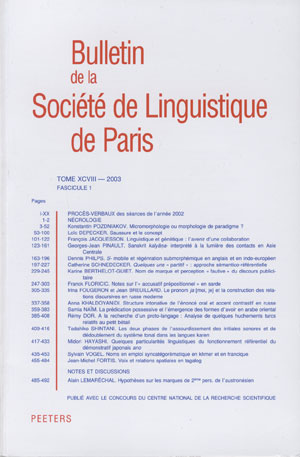 previous article in this issue previous article in this issue | next article in this issue  |

|
Document Details : Title: Reassessing Phonology as a Heuristic Approach Subtitle: The Case of Lydian Author(s): GARNIER, Romain Journal: Bulletin de la Société de Linguistique de Paris Volume: 117 Issue: 1 Date: 2022 Pages: 153-187 DOI: 10.2143/BSL.117.1.3291562 Abstract : The present paper aims at reassessing the phonology of Lydian, a poorly documented First Millenium Anatolian language, whose graphic conventions prove more complex than expected, embedding many phonemes in a short list of characters. On the grounds of internal reconstruction, one may assume ‘new’ phonetic values for Lydian ‹d-›, ‹f›, ‹i›, ‹k›, ‹l›, ‹λ›, ‹m-›, ‹-nl-›, ‹-nt-›, ‹-nτ-›, ‹-o-›, ‹-pt-›, ‹r›, ‹-t-› and ‹u›. The resulting system is reminiscent of what is assumed for Lycian and Carian, thus making Lydian less isolated. Dans la présente contribution, l’on se propose de réexaminer la phonologie du lydien – une langue anatolienne d’attestation fragmentaire du premier millénaire avant notre ère, dont les conventions scripturaires s’avèrent plus complexes qu’on ne s’y attendait, de nombreux phonèmes étant notés par un nombre restreint de caractères. Sur la foi de la reconstruction interne, il est loisible de prêter de nouvelles valeurs phonétiques aux graphèmes lydiens que sont ‹d-›, ‹f›, ‹i›, ‹k›, ‹l›, ‹λ›, ‹m-›, ‹-nl-›, ‹-nt-›, ‹-nτ-›, ‹-o-›, ‹-pt-›, ‹r›, ‹-t-› et ‹u›. Le système phonologique qui en résulte n’est point sans rappeler celui du lycien ou du carien, sortant ainsi le lydien de son isolement. Dieser Aufsatz hat eine Neubewertung der Phonologie des Lydischen zum Ziel, einer in einem schmalen Korpus von Inschriften aus dem 1. Jahrtausend v. Chr. bezeugten anatolischen Sprache. Die graphischen Konventionen erweisen sich als komplexer als erwartet: ein beschränktes Inventar von Graphemen wird für eine Vielzahl an Phonemen verwendet. Mithilfe interner Rekonstruktion werden hier neue Lautwerte für ‹d-›, ‹f›, ‹i›, ‹k›, ‹l›, ‹λ›, ‹m-›, ‹-nl-›, ‹-nt-›, ‹-nτ-›, ‹-o-›, ‹-pt-›, ‹r›, ‹-t-› und ‹u› vorgeschlagen. Das resultierende Phonemsystem gemahnt an das für das Lykische und Karische angenommene; das Lydische erscheint so weniger isoliert. |
|
